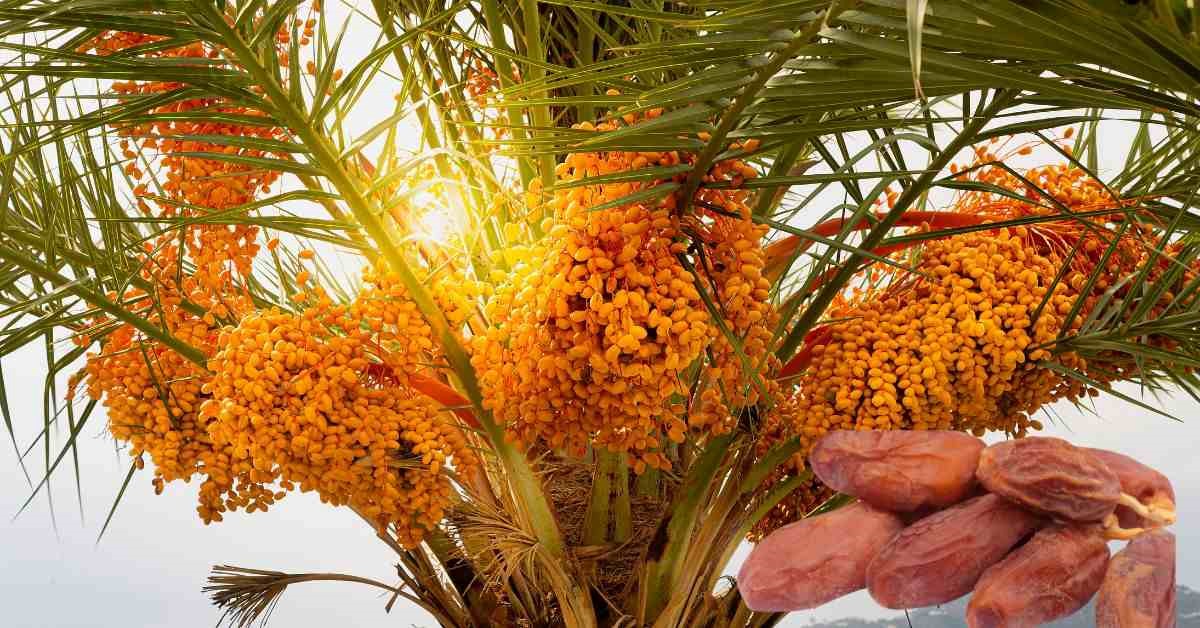Have you ever wondered how the tree that produces those delicious dates gets its distinctive look? With its towering height and unique features, the date palm tree is easily recognizable in landscapes worldwide.
But what exactly makes it stand out? Delving into the details, we’ll explore the characteristics of a date palm tree, from its feathery leaves and rugged trunk to its hidden root system, delicate flowers, and, of course, the sweet, juicy fruits it bears.
Date Palm Tree Identification: Identifying Date Palm Leaves
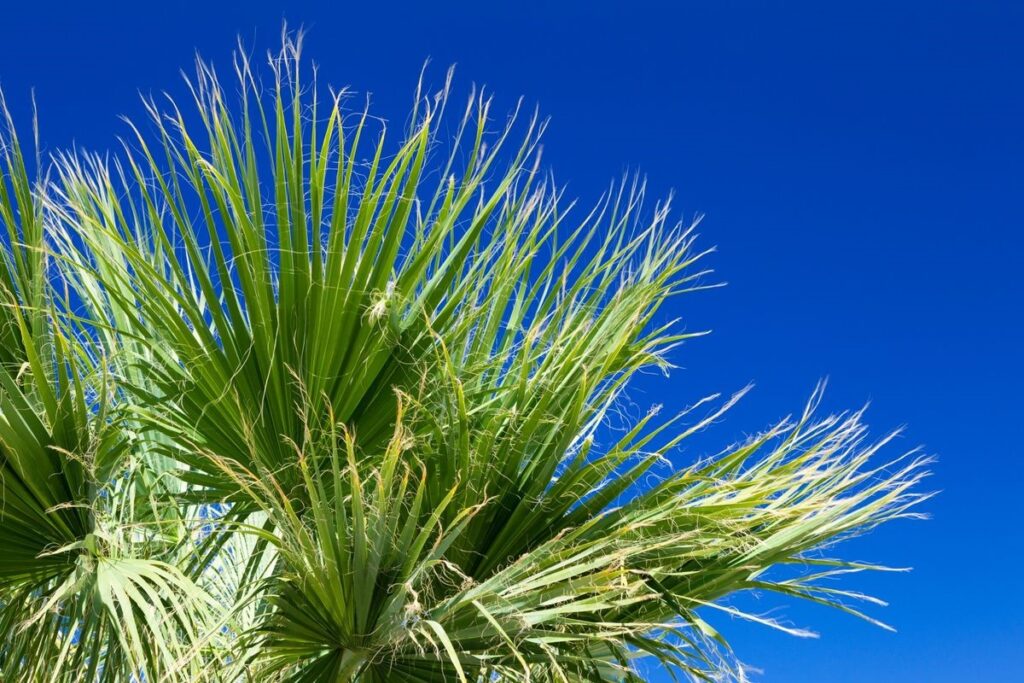
A. Feather vs. Fan-Shaped Leaves
Date palms, such as the Phoenix canariensis, are renowned for their elegant, feather-like leaves, scientifically termed pinnate. These leaves can reach impressive lengths of 15-20 feet, contributing to the tree’s stately appearance. Each frond comprises numerous linear leaflets arranged symmetrically along a central rachis, giving the leaf its characteristic feathered look.
The leaflets exhibit a vibrant, deep green hue, with a subtle grayish tone on the underside, enhancing the tree’s visual appeal. The texture of the leaflets is somewhat leathery, and they taper in size towards the base of the leaf, which is a distinctive feature of the date palm’s foliage. Moreover, the leaf stems are equipped with small hooks, an adaptation that may serve to protect the tree from various herbivores.
In contrast to the pinnate leaves of the date palm, some palm species showcase fan-shaped leaves, known as palmate. These leaves are characterized by several primary veins that spread out from a single point, resembling the fingers of a hand. This leaf structure variation is a key identification marker and reflects the diverse adaptations of palm species to their environments.
B. Color Variations and Texture
The date palm leaves can exhibit a wide range of colors, from a deep glossy green to a more muted gray-green and sometimes even a bluish tint that some describe as soapy green. The texture of the leaves is typically stiff and waxy, providing a robust and durable structure that can withstand harsh desert climates.
- The color intensity and hue may vary depending on the age of the leaf, as well as environmental factors such as sunlight exposure and soil conditions.
- Younger leaves tend to have a brighter green color, which may fade to a more subdued tone as they mature.
It’s important to note that while color and texture are useful identification markers, they can also be influenced by the health and nutrition of the tree. Consistent observation of these characteristics can help understand the date palm’s overall well-being.
C. Date Palm Leaf Stem Characteristics
The Date Palm Tree’s leaf stem, or petiole, plays a crucial role in date palm tree identification. These robust stems range from 6 to 10 feet in length, supporting the large crown of leaves that characterize the date palm tree. The petiole’s margin is typically spiny, providing a protective measure for the tree, and the leaflets exhibit fibrous edges that contribute to the overall stiff texture of the date palm tree leaves.
When learning how to identify a date palm tree, observing the color of the crown shaft is also beneficial. It can vary from olive green to a mix of brown, sometimes displaying a slight bulge at the base. This feature and the absence of ramenta (thin scales or hairs) help distinguish the date palm from other palm species.
In summary, the leaf stem characteristics of a date palm include:
- A lengthy and sturdy petiole
- Spiny margins for protection
- Fibrous edges on leaflets
- A crown shaft that may show color variations and a slight bulge
- These attributes are essential for accurately identifying and appreciating the date palm tree’s unique morphology.
Examining the Trunk of Date Palms
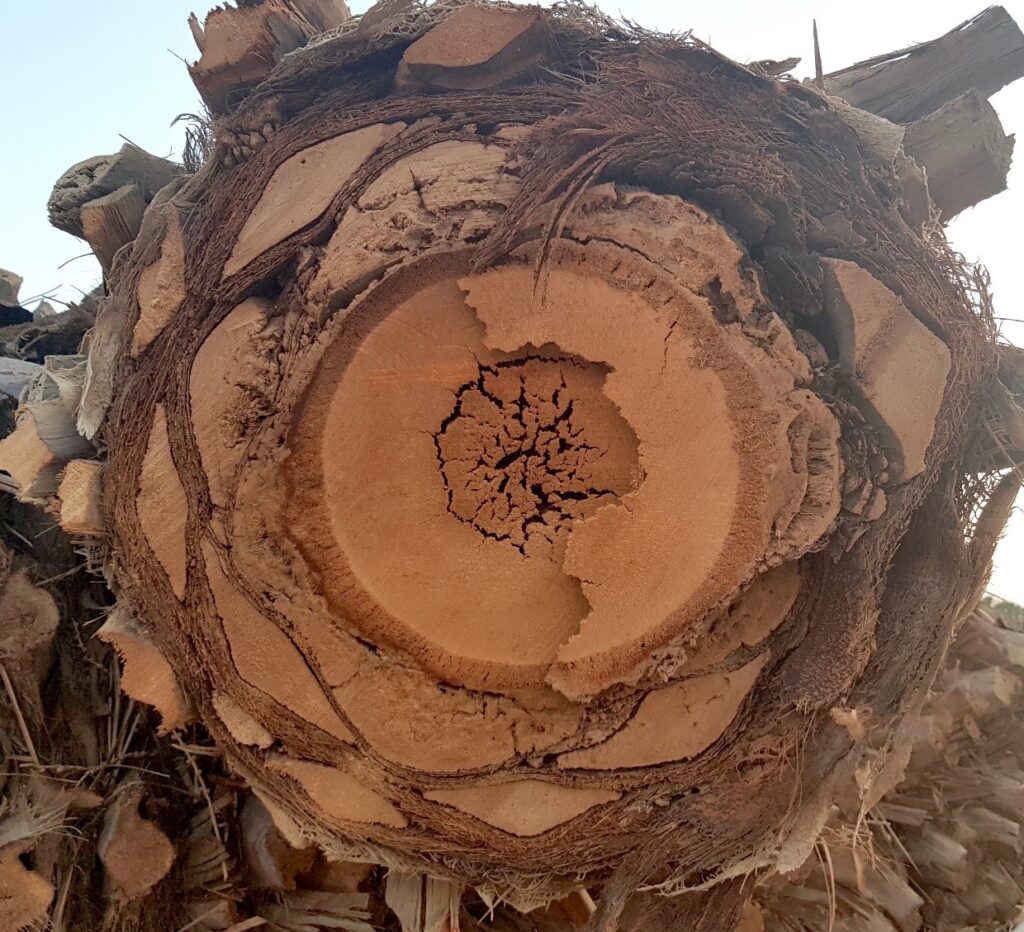
Image By Eliran t – Own work, CC BY-SA 4.0
1. Trunk Height and Diameter
The stature of a date palm tree is a defining characteristic that can be observed even from a distance. Mature date palms typically reach heights ranging from 25 to 35 feet, making them a prominent feature in any landscape. The trunk diameter, on the other hand, is more modest, usually measuring between six to ten inches. This slender profile is often a result of the tree’s growth pattern and environmental adaptations.
When assessing the trunk of a date palm, it’s essential to consider its height and girth. These dimensions indicate the tree’s age and provide insights into its health and the conditions in which it has been growing. For instance:
- A thicker trunk may suggest a well-nourished tree with access to ample resources.
- Conversely, a thinner trunk could indicate a tree that has faced environmental stresses or competition for nutrients.
The trunk dimensions of date palms are a testament to their resilience and ability to thrive in various conditions while also serving as a practical measure for gardeners and landscapers in planning and maintaining these majestic trees.
2. Surface Texture and Patterns
The surface texture and patterns of date palm trunks are distinctive features that aid in their identification. Some trunks exhibit a smooth surface, while others display a unique criss-cross pattern formed by the layering of old leaf bases. This pattern can add a rugged, textured appearance to the trunk.
The presence of a crown shaft is another characteristic to look for. It is an elongated section of the leaf base that can be a different color than the rest of the trunk, providing a striking contrast. For instance, the King Palm is known for its rosy purple crown shaft, which stands out against its trunk.
- Trunks may be straight or tapered, as seen in the Coconut Palm.
- Crownshafts can vary in color and texture, with some being notably fuzzy and touchable, like the Teddy Bear Palm’s rusty red crownshaft.
- The petioles, or leaf stems, can also contribute to the trunk’s texture, either smooth or armed with small spines.
3. Unique Trunk Features
One may notice that portions of the trunks may lose their spines over time when observing date palm tree trunks. However, these spines typically remain prominent throughout most of the trunk, giving the date palm its characteristic rugged appearance.
A single-trunk or a multi-trunk formation is another distinctive aspect of date palms. Single trunks are more common in species like the Coconut or Date Palm, which grow tall and slender. In contrast, multi-trunk palms, such as the Needle Palm, Lady Palm, and Areca Palm, often appear shrub-like and have a longer maturation period.
Unique trunk features can also include variations in color and shape. For instance, the King Palm is known for its rosy purple crownshaft, while other species may exhibit swollen trunks or trunks covered in hairy-looking fibers. These salient botanical features are essential for correctly identifying and appreciating the date palm’s aesthetic.
Understanding Date Palm Roots
I. Root Structure and Growth
The date palm tree roots are a fascinating aspect of this resilient plant. Roots typically extend deeply into the soil, anchoring the tree and seeking moisture and nutrients. This extensive root system is crucial for the tree’s survival, especially in arid environments where water is scarce.
- The primary roots can grow several meters below the surface.
- Secondary roots spread out laterally to stabilize the tree and absorb water.
- Fine root hairs increase the surface area for water and nutrient uptake.
Understanding the growth patterns of date palm roots can inform proper care and cultivation practices, ensuring the health and longevity of these majestic trees.
II. Soil Preferences and Root Health
The health of a date palm’s root system is intricately linked to the soil in which it is planted. Well-draining soil is not just a preference; it is essential for the vitality of these trees. Roots that are subjected to waterlogged conditions are prone to disease and can lead to an overall decline in plant health.
Date palms thrive in soils that balance moisture retention and drainage. A sandy loam is often the ideal choice, providing the necessary aeration and preventing excess water retention. Regular monitoring and adjustments to the soil composition can ensure the roots remain healthy and the tree continues flourishing.
In addition to soil type, the frequency and type of fertilization play a critical role in root health. A balanced NPK fertilizer, applied quarterly, can support robust growth and enhance the tree’s resilience. It’s important to note that the soil preferences of date palms may vary slightly depending on the specific species and local environmental conditions.
III. Impact on Surrounding Landscape
The Date Palm Tree is known for its resilience and adaptability to various environmental conditions. Its ability to thrive in areas with challenges such as persistent fog, wind, sandy soils, and salty air is evident. This robust nature ensures that the Date Palm does not cause undue stress on the surrounding landscape. It is not known to be particularly problematic regarding its root system, which is a significant advantage when considering planting near structures or pavement.
However, care should be taken to monitor the growth and health of the Date Palm to prevent any potential damage. The tree’s non-invasive roots contribute to a harmonious garden ecosystem, making it a preferred choice for urban and residential areas. The adaptability of the Date Palm is further highlighted by its ability to maintain a consistent growth cycle, even in less-than-ideal conditions, unlike some other species that may require additional care or may not survive at all.
Recognizing Date Palm Flowers
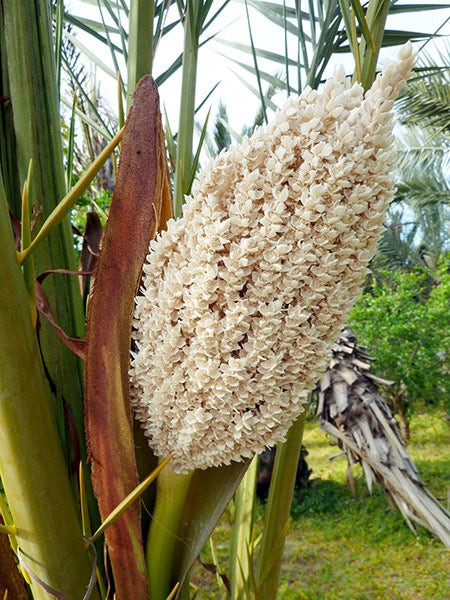
Image by: Date Palms – Oasis Date Gardens
A. Flower Arrangement and Appearance
The date palm tree flowers are known for their distinctive arrangement, typically growing in clusters along the stems. These flowers are not particularly vibrant or flashy, often presenting a more subdued aesthetic. Clusters of flowers emerge from the spathe, which is a protective covering that splits open when the flowers are ready to bloom.
Date palm flowers exhibit a range of colors, usually from creamy white to light green, indicating their readiness for pollination. The blossoms of the date palm are relatively short-lived, lasting about three weeks before they give way to fruit development.
It’s important to note that the flowering period of date palms is seasonal, with blooms appearing in early spring. This timing is crucial for pollination, which leads to the production of date fruits that are highly valued worldwide.
B. Pollination and Seasonal Changes
Date palm trees exhibit a fascinating pollination process crucial for fruit production. Pollination typically occurs in the spring, when male flowers release pollen carried by wind or manually transferred to the receptive female flowers. This period is marked by a flurry of activity within the date palm canopy.
- The flowering season extends from spring to early summer, lasting approximately 4-6 weeks.
- Following pollination, the development of fruits occurs, with the harvest time peaking from late summer to autumn.
It is important to note that date palms have separate male and female trees, and only the female trees bear fruit. Seasonal changes can influence the pollination efficiency and subsequent fruit yield. For instance, a moderate growth rate and adequate light requirements are essential for optimal flowering and fruiting. Expert tips for palm tree trimming, such as pruning for health, beauty, and safety, can also impact pollination by improving light penetration and reducing disease pressure.
C. Differences Between Male and Female Flowers
Date palms exhibit sexual dimorphism, meaning they have distinct male and female flowers on separate trees. Male flowers are primarily responsible for producing pollen necessary to fertilize female flowers. These male inflorescences are less conspicuous compared to their female counterparts.
Female flowers, on the other hand, contain carpels that develop into fruits once pollination occurs. They are typically more extensive and prominent, making them easier to identify. The differences between male and female flowers are crucial for the pollination process and subsequent fruit production:
- Male flowers release pollen into the air.
- Female flowers capture the pollen to fertilize the ovules.
- Successful pollination leads to the development of date fruits.
Understanding these differences is essential for date palm cultivation and ensuring a successful harvest.
Describing Date Palm Fruits
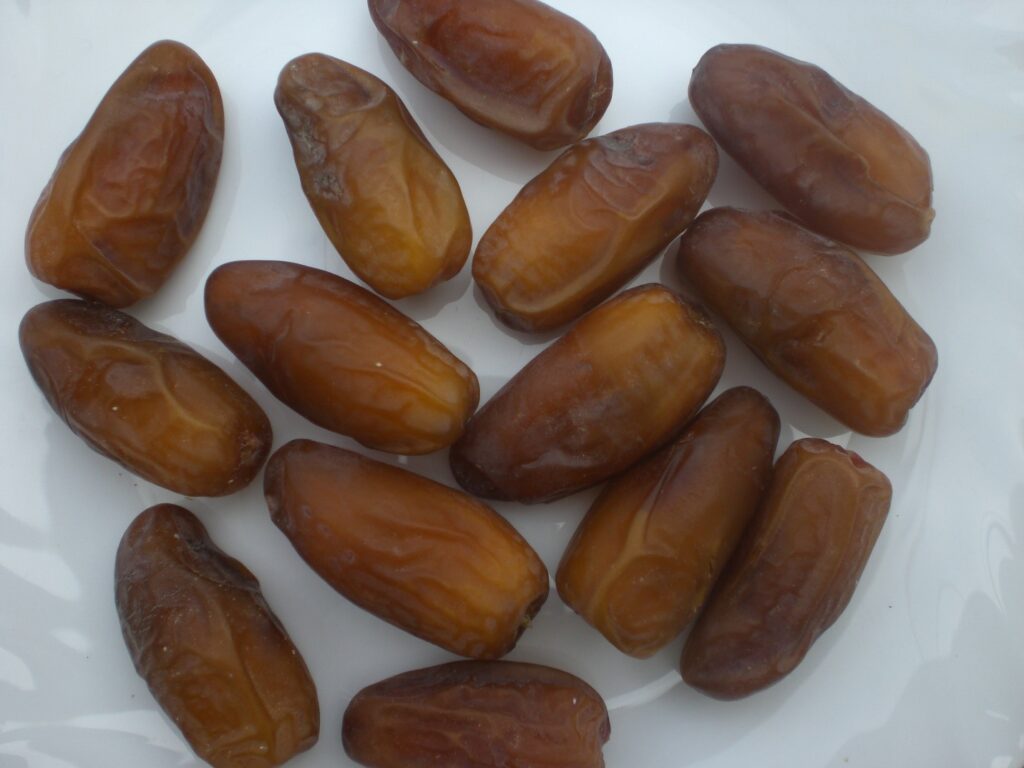
Image By M. Dhifallah – M. Dhifallah, CC BY-SA 3.0
I. Fruit Development and Ripening
The journey of date palm fruits from pollination to ripeness is fascinating. Initially, the fruits are small, green, and hard, but as they mature, they undergo significant changes in size, color, and texture. The ripening stage is crucial, as it determines the sweetness and quality of the dates.
- During the early stages of development, the fruits are high in moisture and low in sugar.
- As they ripen, dates increase in size and gradually transition from green to a rich brown or black color, indicating peak ripeness.
- The final stage of ripeness is characterized by a wrinkled texture and concentrated sweetness, making them ideal for harvest.
Harvest time typically spans from late summer to autumn, aligning with the natural ripening cycle of the fruit. During this period, the dates reach their optimal flavor and texture, ready to be enjoyed fresh or processed for various culinary uses.
II. Varieties of Date Fruits
The date palm tree fruits are as diverse as they are delectable, with numerous varieties cultivated around the world. Each variety has its unique taste, size, and color, making it a fascinating subject for both connoisseurs and casual consumers alike.
Some well-known varieties include the Medjool, known for its large size and sweet flavor; the Deglet Noor, prized for its delicate taste and firm texture; and the Barhi, with its round shape and syrupy sweetness. These are just a few examples of the many types of date fruits that grow on date palm trees.
In addition, there are lesser-known varieties local to specific regions, each with its own set of characteristics that cater to the local palate and climate. Exploring the range of date palm tree fruits can be a delightful journey through taste and tradition.
III. Harvesting and Culinary Uses
The harvesting of date fruits is a meticulous process that typically involves hand-picking the ripe dates to ensure their quality. Once harvested, dates offer a versatile range of culinary applications. Dates from a date palm can be used in various recipes, including desserts, smoothies, salads, and savory dishes. They can be stuffed with nuts or cheese, providing a delightful combination of sweet and savory flavors.
In addition to fresh consumption, dates can be dried for long-term storage, retaining their sweetness and nutritional value. Dried dates are a staple ingredient in many Middle Eastern and North African cuisines. They are often crucial in traditional dishes and festive treats, such as Ma’amoul cookies and Date Halva. The preservation of dates through drying also allows them to be enjoyed year-round, making them a valuable commodity in the culinary world.
- Fresh dates can be enjoyed as a healthy snack.
- Dried dates are used in a variety of sweet and savory recipes.
- Dates are a culturally significant food in many regions, often associated with hospitality and celebrations.
Conclusion
In summary, the identification of date palm trees and other palm species involves a close examination of their distinctive features such as leaves, trunk, roots, flowers, and fruits. From the fan-shaped or feather-like fronds to their trunks’ unique textures and shapes, each characteristic provides clues to the species’ identity.
Whether the tall and slender coconut palm with its iconic coconuts or the Pygmy Date Palm often sold as ‘triples,’ understanding these features can lead to accurate identification. Utilizing online tools or mobile apps can further assist in distinguishing between the various types of palms.
Appreciating these details can help you identify these tropical beauties and gain insight into their ecological roles and cultural significance.

